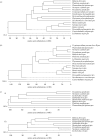DNA topoisomerases in apicomplexan parasites: promising targets for drug discovery
- PMID: 20200034
- PMCID: PMC2871873
- DOI: 10.1098/rspb.2009.2176
DNA topoisomerases in apicomplexan parasites: promising targets for drug discovery
Abstract
The phylum Apicomplexa includes a large group of protozoan parasites responsible for a wide range of animal and human diseases. Destructive pathogens, such as Plasmodium falciparum and Plasmodium vivax, causative agents of human malaria, Cryptosporidium parvum, responsible of childhood diarrhoea, and Toxoplasma gondii, responsible for miscarriages and abortions in humans, are frequently associated with HIV immunosuppression in AIDS patients. The lack of effective vaccines, along with years of increasing pressure to eradicate outbreaks with the use of drugs, has favoured the formation of multi-drug resistant strains in endemic areas. Almost all apicomplexan of medical interest contain two endosymbiotic organelles that contain their own mitochondrial and apicoplast DNA. Apicoplast is an attractive target for drug testing because in addition to harbouring singular metabolic pathways absent in the host, it also has its own transcription and translation machinery of bacterial origin. Accordingly, apicomplexan protozoa contain an interesting mixture of enzymes to unwind DNA from eukaryotic and prokaryotic origins. On the one hand, the main mechanism of DNA unwinding includes the scission of one-type I-or both DNA strands-type II eukaryotic topoisomerases, establishing transient covalent bonds with the scissile end. These enzymes are targeted by camptothecin and etoposide, respectively, two natural drugs whose semisynthetic derivatives are currently used in cancer chemotherapy. On the other hand, DNA gyrase is a bacterial-borne type II DNA topoisomerase that operates within the apicoplast and is effectively targeted by bacterial antibiotics like fluoroquinolones and aminocoumarins. The present review is an update on the new findings concerning topoisomerases in apicomplexan parasites and the role of these enzymes as targets for therapeutic agents.
Figures

Similar articles
-
Novel findings on trypanosomatid chemotherapy using DNA topoisomerase inhibitors.Mini Rev Med Chem. 2009 Jun;9(6):674-86. doi: 10.2174/138955709788452775. Mini Rev Med Chem. 2009. PMID: 19519493 Review.
-
Biosynthetic pathways of plastid-derived organelles as potential drug targets against parasitic apicomplexa.Curr Drug Targets Immune Endocr Metabol Disord. 2003 Jun;3(2):99-109. doi: 10.2174/1568008033340261. Curr Drug Targets Immune Endocr Metabol Disord. 2003. PMID: 12769782 Review.
-
The plastid-like organelle of apicomplexan parasites as drug target.Curr Pharm Des. 2008;14(9):855-71. doi: 10.2174/138161208784041105. Curr Pharm Des. 2008. PMID: 18473835 Review.
-
Phylogeny and evolution of apicoplasts and apicomplexan parasites.Parasitol Int. 2015 Jun;64(3):254-9. doi: 10.1016/j.parint.2014.10.005. Epub 2014 Oct 14. Parasitol Int. 2015. PMID: 25451217 Review.
-
Complex Endosymbioses II: The Nonphotosynthetic Plastid of Apicomplexa Parasites (The Apicoplast) and Its Integrated Metabolism.Methods Mol Biol. 2018;1829:37-54. doi: 10.1007/978-1-4939-8654-5_3. Methods Mol Biol. 2018. PMID: 29987713 Review.
Cited by
-
Target-similarity search using Plasmodium falciparum proteome identifies approved drugs with anti-malarial activity and their possible targets.PLoS One. 2017 Oct 31;12(10):e0186364. doi: 10.1371/journal.pone.0186364. eCollection 2017. PLoS One. 2017. PMID: 29088219 Free PMC article.
-
Plasmodium falciparum UvrD activities are downregulated by DNA-interacting compounds and its dsRNA inhibits malaria parasite growth.BMC Biochem. 2014 Apr 3;15:9. doi: 10.1186/1471-2091-15-9. BMC Biochem. 2014. PMID: 24707807 Free PMC article.
-
Trypanosomatids topoisomerase re-visited. New structural findings and role in drug discovery.Int J Parasitol Drugs Drug Resist. 2014 Aug 24;4(3):326-37. doi: 10.1016/j.ijpddr.2014.07.006. eCollection 2014 Dec. Int J Parasitol Drugs Drug Resist. 2014. PMID: 25516844 Free PMC article. Review.
-
Replacement of the human topoisomerase linker domain with the plasmodial counterpart renders the enzyme camptothecin resistant.PLoS One. 2013 Jul 2;8(7):e68404. doi: 10.1371/journal.pone.0068404. Print 2013. PLoS One. 2013. PMID: 23844196 Free PMC article.
-
Peptide Inhibition of Topoisomerase IB from Plasmodium falciparum.Mol Biol Int. 2011;2011:854626. doi: 10.4061/2011/854626. Epub 2011 May 4. Mol Biol Int. 2011. PMID: 22091414 Free PMC article.
References
-
- Aravind L., Leipe D. D., Koonin E. V.1998Toprim: a conserved catalytic domain in type IA and II topoisomerases, DNAG-type primases, OLD family nucleases and RecR proteins. Nucleic Acids Res. 26, 4205–4213 (doi:10.1093/nar/26.18.4205) - DOI - PMC - PubMed
-
- Auparakkitanon S., Wilairat P.2000Cleavage of DNA induced by 9-anilinoacridine inhibitors of topoisomerase II in malaria parasite, Plasmodium falciparum. Biochem. Biophys. Res. Commun. 269, 406–409 (doi:10.1006/bbrc.2000.2305) - DOI - PubMed
-
- Balana-Fouce R., Redondo C. M., Perez-Pertejo Y., Diaz-Gonzalez R., Reguera R. M.2006Targeting atypical trypanosomatid DNA topoisomerase I. Drug Discov. Today 11, 733–740 (doi:10.1016/j.drudis.2006.06.014) - DOI - PubMed
-
- Bates A. D., Maxwell A.2007Energy coupling in type II topoisomerases: why do they hydrolyze ATP? Biochemistry 46, 7929–7941 (doi:10.1021/bi700789g) - DOI - PubMed
Publication types
MeSH terms
Substances
LinkOut - more resources
Full Text Sources
Other Literature Sources

